Six games into the current Serie A campaign brought us a battle between one expected title challenger and one European hopeful – Internazionale vs Torino, a battle which saw Inter snatch a 1-0 victory, thanks to a late goal from Marcelo Brozović. The win leaves Internazionale in sixth place after they recorded their fourth win of the season, while Torino sit in ninth position. The win for Inter gained even more importance following positive results for the teams around them in the table – three points allowed them to stay in the title picture early doors.
This tactical analysis will provide insight into the performance of Inter in key tactical areas. This includes an analysis of Inter’s tactics in attack, as well as how they performed out of possession as their goalkeeper and defensive unit were kept busy at times yet managed to keep a clean sheet.
Lineups

Simeone Inzaghi set his team up in a 3-5-2 shape in a game that saw Edin Dźeko given a start alongside Lautaro Martínez due to the absence of the injured Romelu Lukaku. Nicoló Barella came back into the fold following Inter’s midweek defeat to Bayern Munich in the UEFA Champions League, while former Manchester United man Matteo Darmian returned to the side at left wing-back. Two changes at centre back saw Federico Dimarco and Milan Škriniar come into play, while Samir Handanović was on hand between the sticks to keep a clean sheet for his side.
Meanwhile, Torino opted for a 3-4-2-1 formation. One change at the heart of the defence saw Alessandro Buongiorno reintroduced, while Karol Linetty played in central midfield. A slight change in shape from their last game (where they played a 3-4-1-2) saw Demba Seck brought into the attacking midfield lineup. Antonio Sanabria led the line for the visitors.
Inter – playing out from the back and utilising wing play in transitional attacks
To no surprise, Inter controlled a high portion of possession throughout the game (57%), which often allowed them to dictate the tempo and somewhat limit Torino’s momentum and pressing intensity. The hosts’ three-at-the-back shape allowed their wing-backs to take up high and wide positions to support the tactics of playing through the thirds, as well as playing into Inter’s methods of getting the ball wide when possible.
This segment of analysis will take a look at how Inter looked to utilise their possession but also how they reacted in attacking transitions.
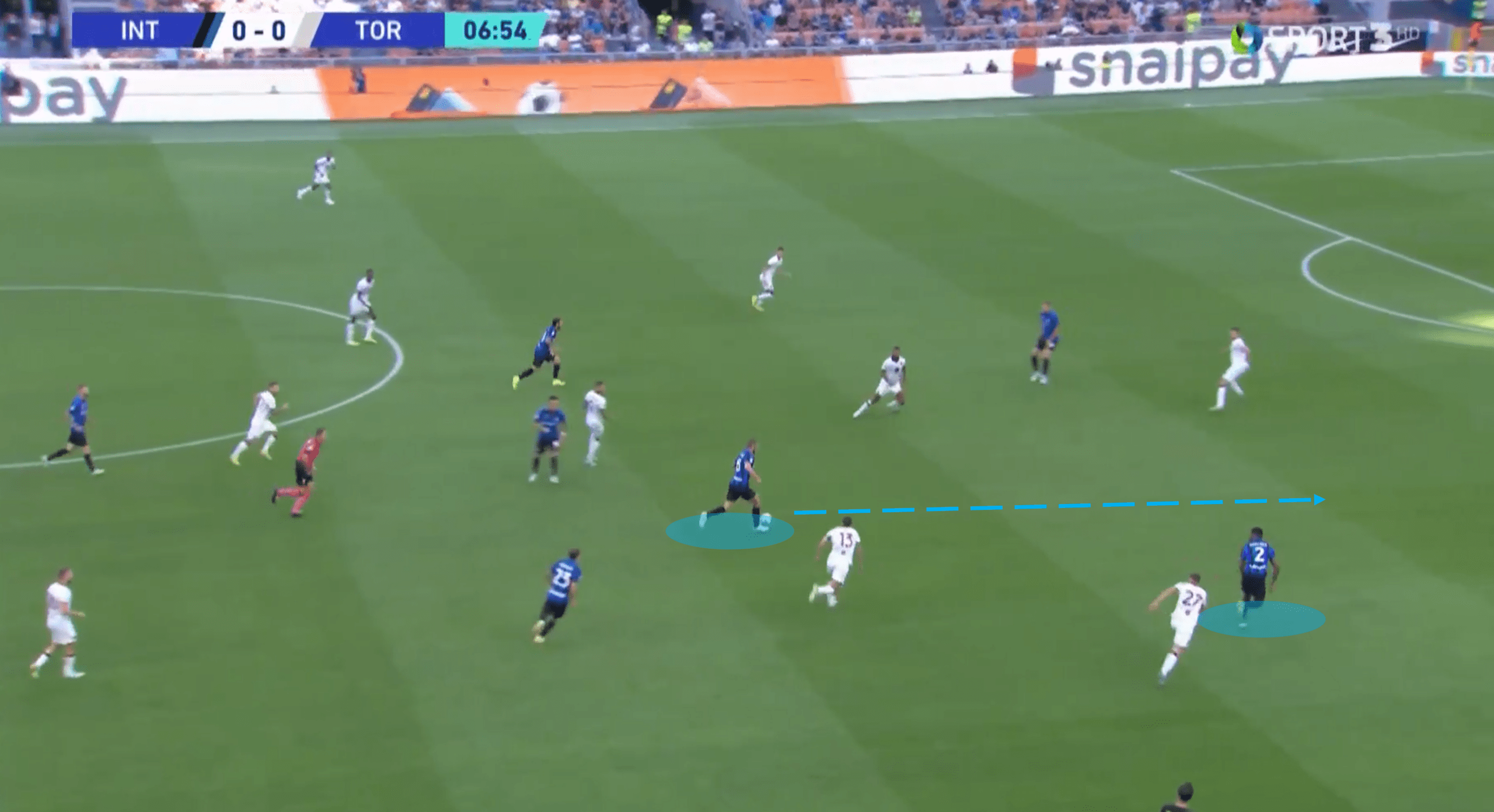
As the analysis will cover later, Inter put pressure on Torino right out of the blocks. Naturally, this led to turnovers in midfield areas that allowed the home side to launch quick and dangerous attacks. As mentioned, Inter’s wing-backs would often be present in their attacking ventures and transitional attacks were no different. Dźeko had dropped in deeper to offer his physicality as support in the transition, and quickly found himself with the ball yet under little pressure. With Denzel Dumfries recognising the possibility of causing damage in this situation, the Dutchman made a bursting run into the space left by Torino in the midst of the transition.
Dźeko dropping deeper is an interesting feature in Inter’s tactics in this fixture as it offers a different dimension to their build-up play than when Lukaku is present instead. While Lukaku does occasionally drop in to offer link-up support, Dzeko seems to do this more often and takes up better positions thanks to his vast experience and creative mind.
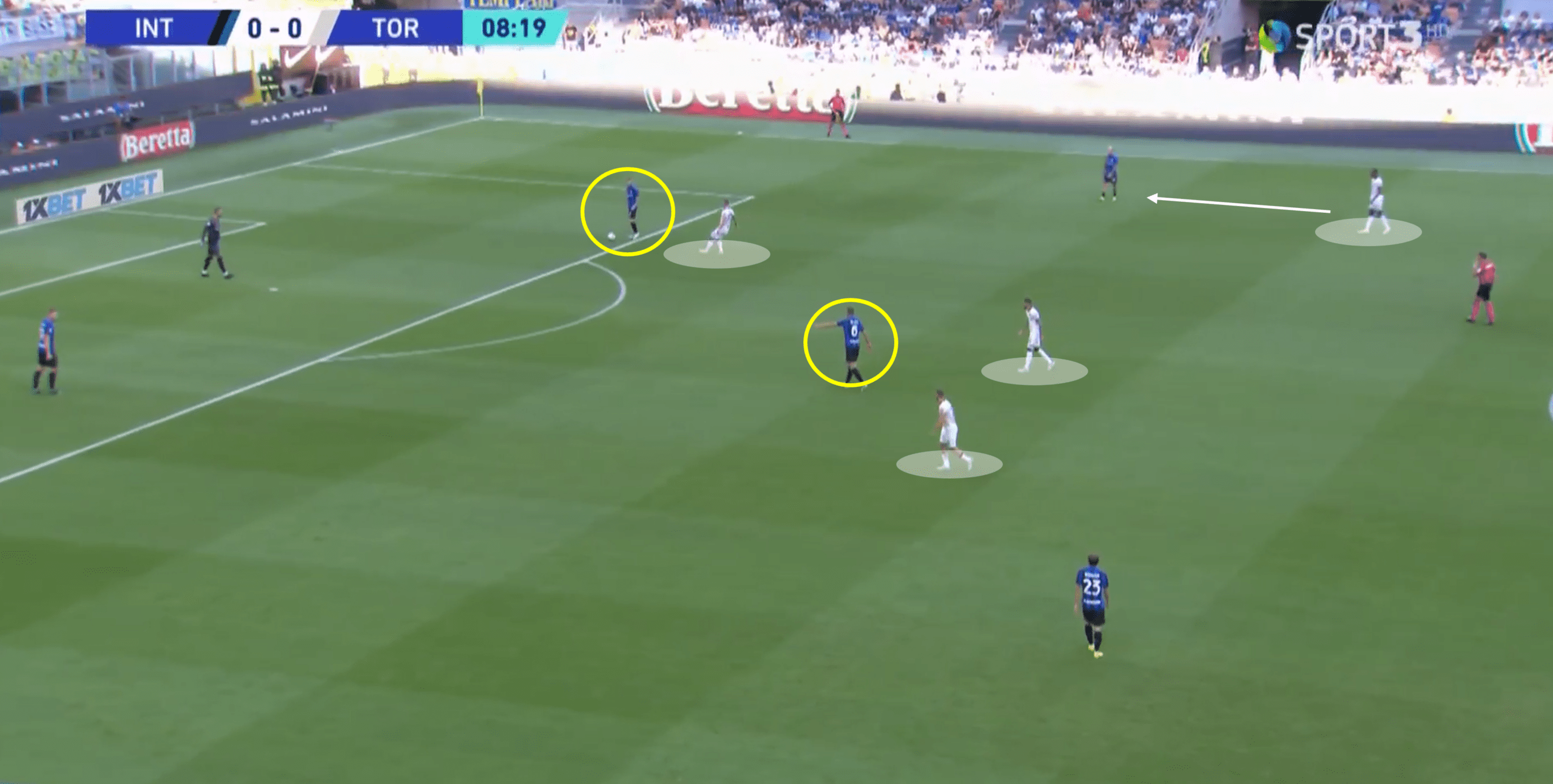
Teams who want to play through the thirds have tactics and systems in place to prepare themselves for playing in such a way in any area of the pitch. Playing out from the back, as seen in the image above, might seem dangerous given the opposition’s presence – and it can be – but Inter have deployed a textbook method to help them move possession further up the pitch.
The man on the ball for Inter is Brozović, who, in situations like this, drops into the defensive unit while de Vrij would step out into Brozović’s original position, practically swapping positions. This is a subtle but clever detail, and it is a tactic we see from many teams who look to control possession. Frenkie de Jong used to do just this multiple times a game during his Ajax days, and he is just one example. The positional swap allows Inter to have a more technically reliable player in control of the ball in a potentially dangerous area while having the centre-back push into the midfield position offers solidarity and protection in that area.
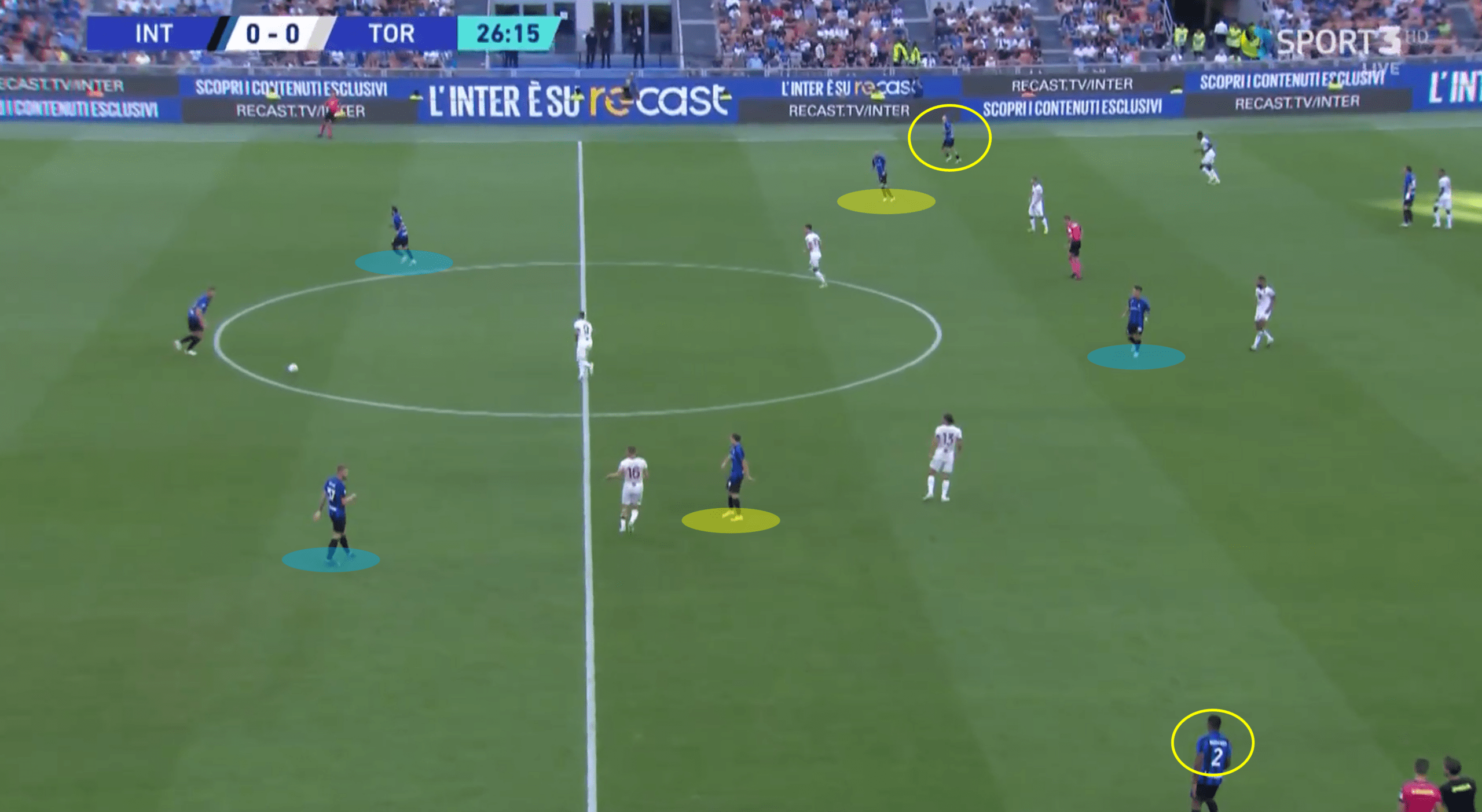
When Inter were able to progress higher up the pitch, this is often how their set-up would look like. While Martinez and Dźeko would alternate in the role of dropping in deeper to provide support, this role really allowed Inter’s midfielders to push into wider positions so that each wing-back had at least one midfielder supporting close by.
These tactics allow Inter to have possession while moving it in productive directions but also set themselves up for the wing play method we discussed earlier in the analysis. In scenarios where the ball did in fact go wide, Dźeko and/or Martinez would then become more involved in the link-up play between the midfield and attacking thirds – where Inter would look to drastically ramp up the tempo.
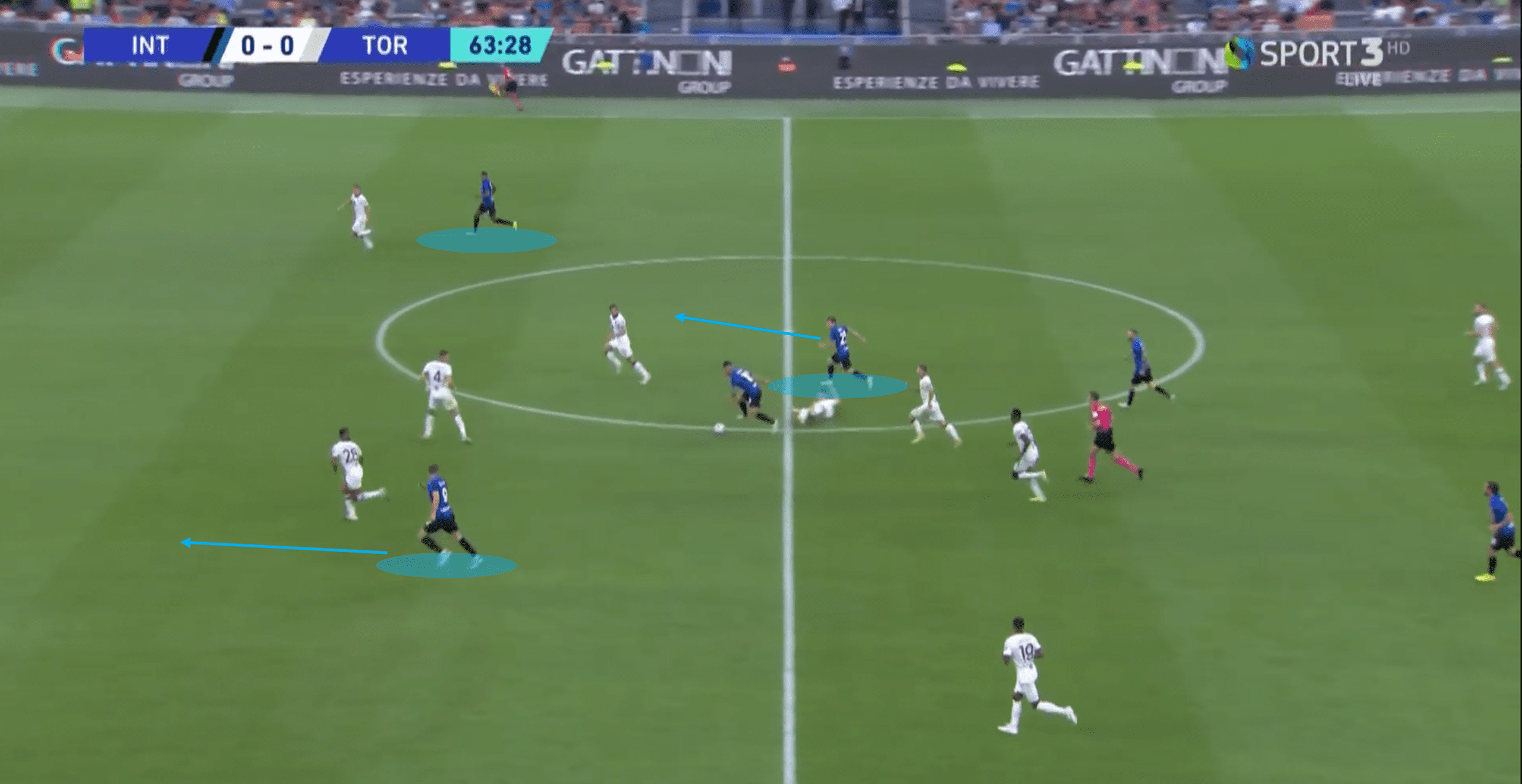
Here we have another example of Inter pushing for an attack following a turnover in possession. While Inter do not have the quickest set of players on paper, their overall numerical presence in the midfield and attacking areas allows them to push forward as a unit to strike fear into the opposition during a counterattack. As per their usual tactics on the ball, they would look to stretch the opposition by adding width to the transitional attack – in this case, the front two players would angle their runs slightly wider to draw their makers away from the centre to create space.
The man with the ball would often not face immediate pressure as the opposition are primarily focused on getting numbers back in position to defend the attack and don’t want to risk leaving more space exposed by pressing the man on the ball. Alongside the midfielder in possession, an extra midfielder would make a bursting run forward to act as a presence booster to give the opposition, even more, to consider defensively. While Dźeko is a man of great experience and talent, it’s in attacks like this that they missed their star man in Romelu Lukaku. The Belgium striker is often the difference maker thanks to his terrific movement and raw power.
Inter’s tactics off-the-ball
Due to a number of contributing factors, Inter were very rarely pinned into their own defensive third while Torino attacked. Key factors such as Inter’s general tactics, their recovery once they lost possession, and their confidence thanks to being the match favourites and the home team all played a part in this. Inzaghi’s men looked to press with intensity from the first whistle and had smart plans in place in terms of defensive tactics, which are discussed in the analysis below.
Also discussed is their decision to continue with pressing tactics deep into the second half which left them exposed in some areas thanks to fatigue kicking in.
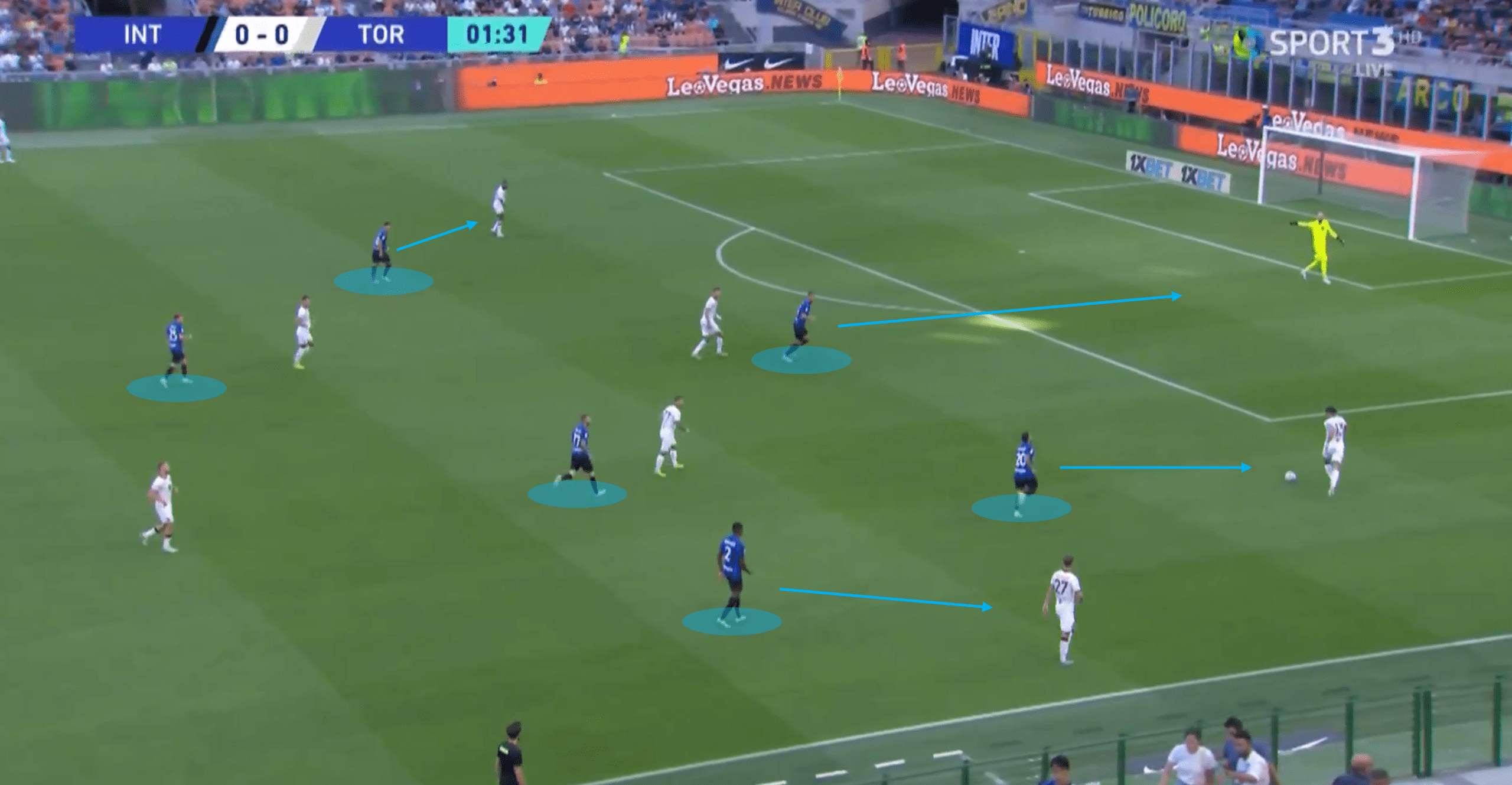
As mentioned, Inter looked to pile the pressure on their counterparts immediately. The idea behind these tactics was to simply force Torino into either a mistake in close proximity or to force them into playing a long ball/clearance to cause a turnover in possession. This went hand in hand with Inter’s tactics of controlling the tempo of the game and having high portions of possession in high areas of the pitch.
The press itself was nothing extravagant and it didn’t need to be – the closest player pressing the man on the ball while other players mark/ready themselves to press another opponent. Additionally, the added presence of midfielders high up the pitch limits Torino’s options even more.
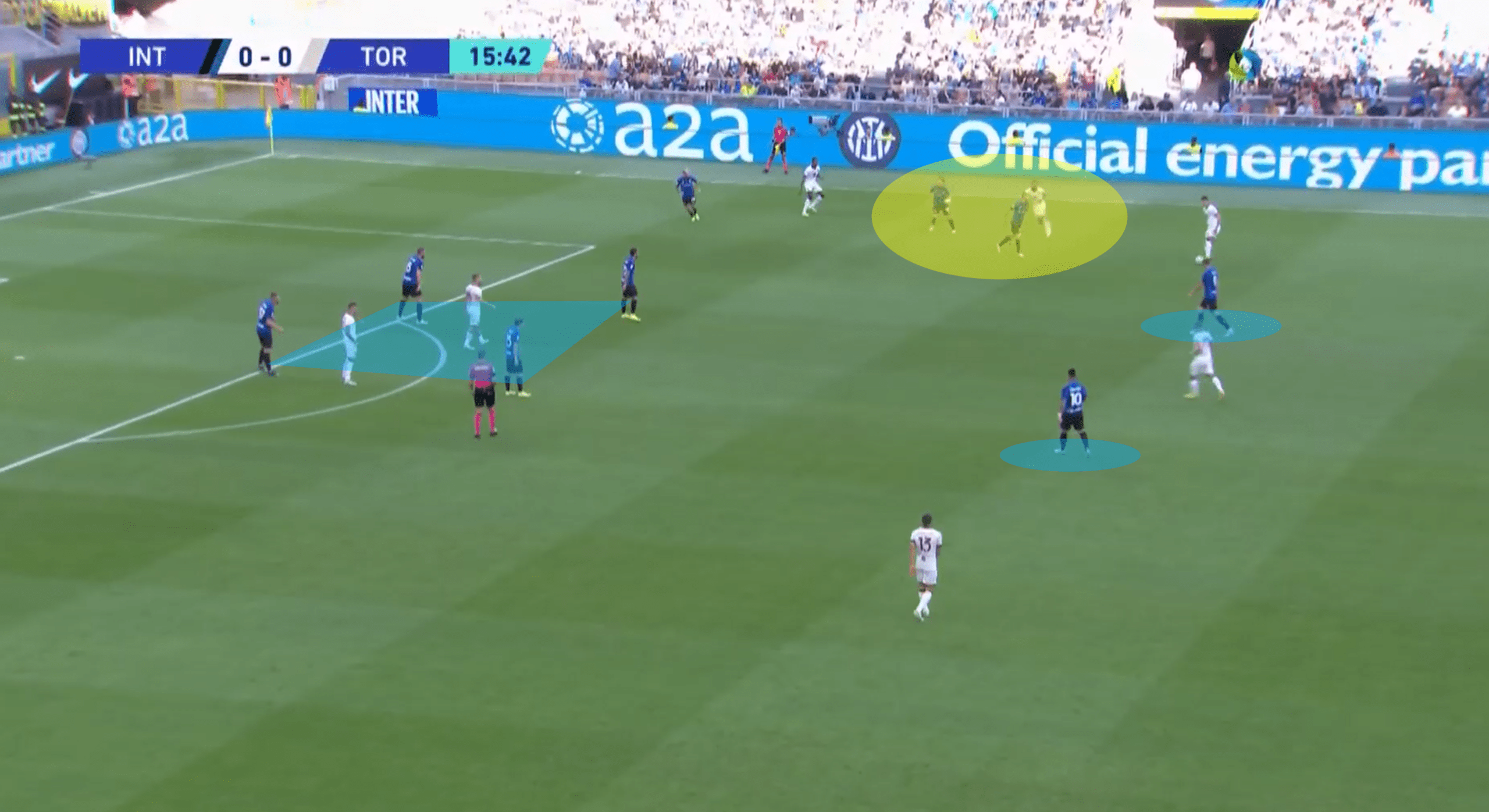
While Inter were primarily focused on controlling the game and its tempo to their own liking, they also had tactics in place for those times when Torino had their share of possession. The visitors often looked to attack from wide areas but tried avoiding a direct method – this resulted in having more players present out wide and a low presence centrally. To combat this, both Dźeko and Martinez would track back and offer defensive support in central areas, which allowed Inter’s midfielders to defend out wide against Torino’s wide attacks.
Centrally, the two remaining midfielders would sit in close proximity to their central defenders, severely limiting the space Torino would have to work in if the ball reached that area. Furthermore, it also limits Torino’s options going forward as the defenders are the ones marking the forwards, but the two midfielders essentially block the passing lines to them.
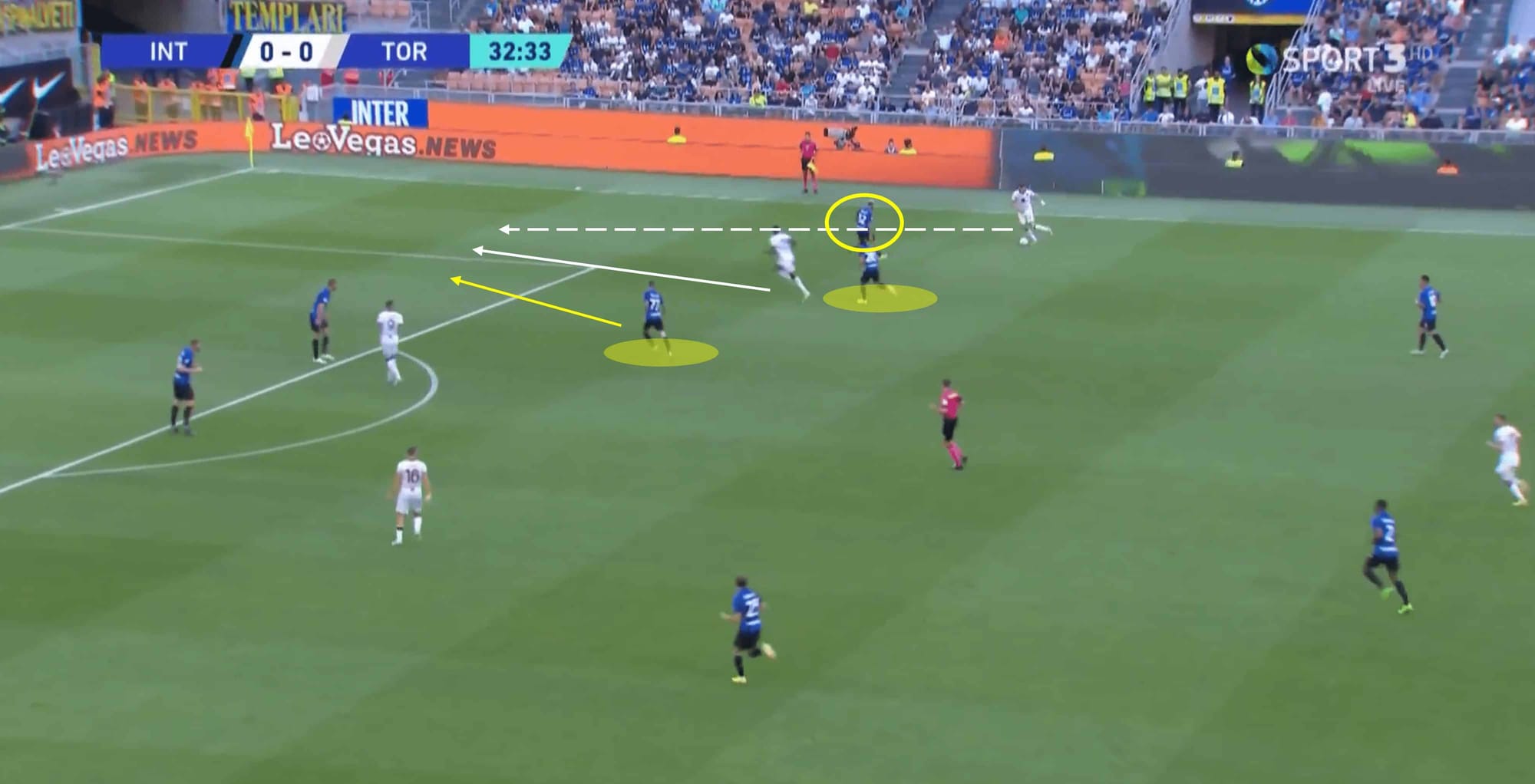
Demba Seck was brought into the Torino side to add something different to the attacking unit of their midfield, and he provided a spark with his clever movements, particularly in wide areas. A recurring pattern when Torino had possession in wide areas was that Inter’s wing-backs, particularly on the left side, would rush out to press the man on the ball, leaving space in behind them to be exploited.
Whether this is a breakdown in communication/lack of understanding of the tactics from Inter as a defensive unit, or just Darmian being rash and rushing out to try and win the ball back quickly, it is an issue Inter need to resolve quickly as they were frankly quite lucky to not be punished by Torino this time around. Once Darmian had decided to press the ball, the responsibility to follow and mark Seck then falls to either of the highlighted Inter midfielders. This is not done immediately, and Seck was free to receive the ball near the byline in a dangerous area.
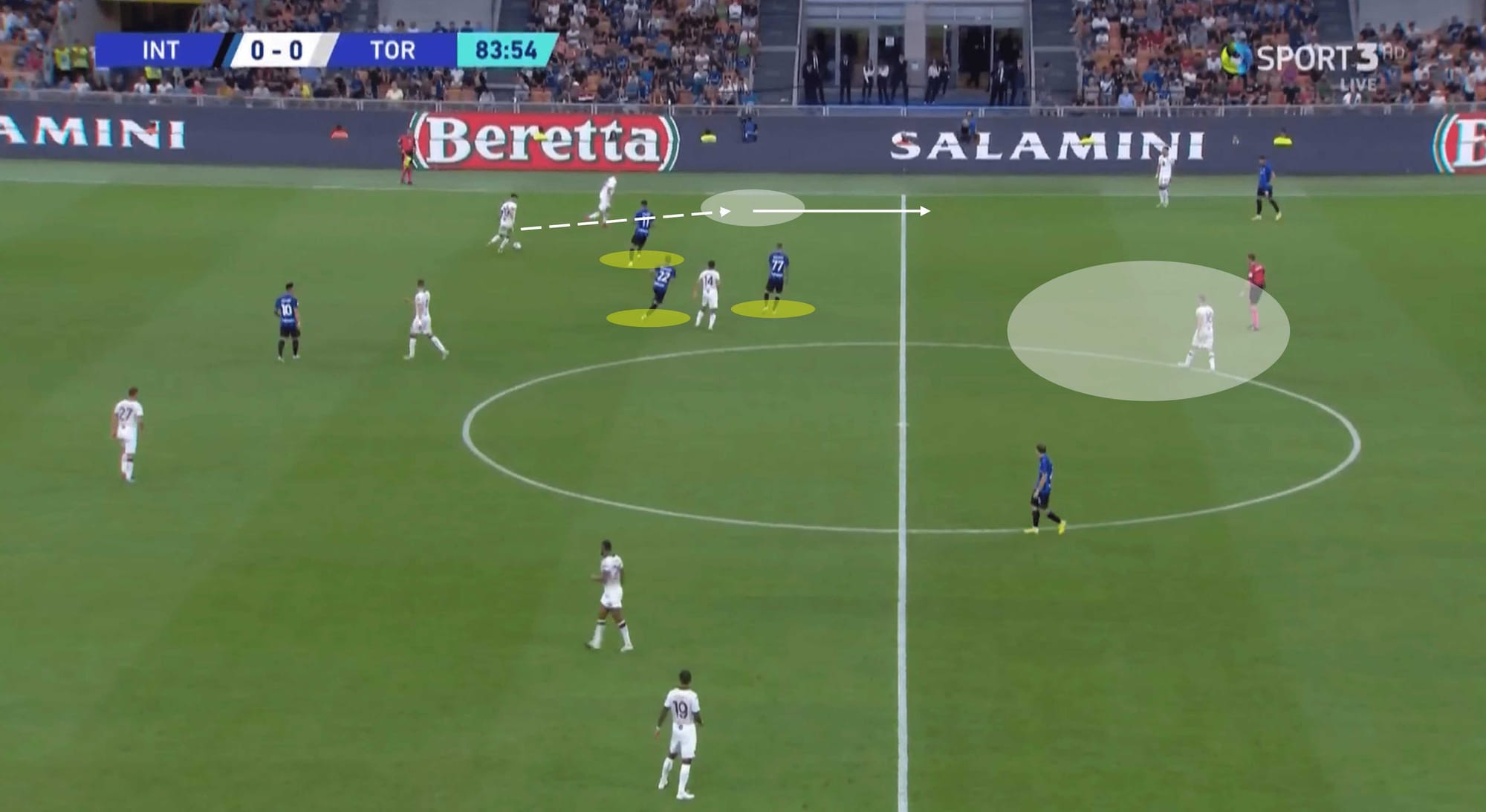
While pressing tactics can be very successful in terms of limiting your opponent’s chances of going forward, the risk of said tactics drastically increases in the latter stages of a game. Some teams are very aware of this and tend to ease off on the pressing, while some still look to press the ball – especially when they aren’t winning. On this occasion, Inter fall into the second category, and the results weren’t pretty.
There are a few notable weaknesses in this particular press and overall defensive set-up from the hosts. The three yellow highlighted players seem to have little idea of their individual responsibilities – because why do you need three players that close together, doing so little, especially when there is no backup behind you? This left space just in front of the halfway line which Torino could have, and probable should have, exploited quickly.
The press itself on the ball by the yellow highlighted was poor and lacked energy, and simply allowed Torino to ease past and play down the left flank. This was another defensive factor that Inter were lucky not to be punished for.
Conclusion
This tie was not a ground-breaking one, in terms of tactics. From Inter’s point of view, they will certainly take some positives in their performance; they will be fully aware that the standard must rise as the season goes on, though. They looked like a team still coming to grips with their tactics, especially on an individual basis i.e. individual roles.
Defensively, there are some question marks for Inzaghi’s side, so there could be a few tweaks occurring in the coming weeks – both tactically and in terms of personnel. Torino performed with courage and heart, and probably deserved something from this tie – but they will take the positives from what is, on paper at least, one of the most daunting fixtures of the season.






Comments